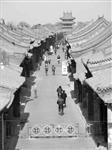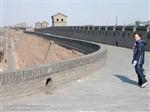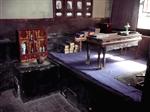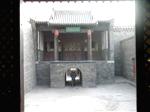- Getting around Lijiang. Dont stay in the Old Towns more than 2 days, there is nothing to do. KRISS Oct 9, 2013 05:46
- 2013 Beijing Temple Fair BENNYLAU Feb 26, 2013 03:29
- Malaysian traveling from KUL - LAX vis Shanghai PVG ZATI_DY Jan 3, 2013 20:15
China's Time Machine: Pingyao's Old City
- Views: 7442
- |Vote: 1 0
- |Add to Favorites
- |Recommend to Friends
It was well past midnight when my wife and I stepped off the sleeper bus onto the side of a very long and dimly lit highway. As the bus’ red tail lights disappeared into oblivion and our eyes began to readjust to the lack of light, our bodies registered the fact that it was a chilly evening and we were happy to be wearing out jackets. Being dropped off in the middle of nowhere could be scary in any country, especially in this weather, but for some reason here in China, I felt both confident and prepared. Next to us on the road was a large sign barely visible in the moonlight. It read: “Next Exit: Pingyao”.
It all seemed like a dream when we woke up the next morning in a small guesthouse somewhere – we weren’t sure where - within the city. I vaguely remember a small motorized rickshaw finally picking us up near the highway exit and transporting us to our beds through the heavy darkness that shrouded the countryside, making it impossible for us as passengers to see where we were headed. I distinctly remember entering Pingyao’s old city, passing under the wall that protects it on all sides, and thinking about how it felt like we were back in Xi’an entering the gate of its walled city. No sounds and very few lights greeted us as we moved our bags from the tiny rickshaw to the guesthouse where we paid our room fee and almost instantaneously fell asleep upon hitting the bed.
As we began to walk around that next morning, however, we realized that this city was more than a dream, it was our chance to travel in time through China’s history and experience life as it was in the Ming and Qing Dynasties. Our research prior to arriving in Pingyao told us that this city was founded in the 14th century by the Ming Emperor Hongwu and became well known as the financial and banking center of China. Fortunately for many tourists today, Pingyao has managed to avoid vast modernization for the 600 years since it’s founding by retaining most all of its ancient buildings, narrow stone-cobbled streets, and city wall, but as the city becomes a popular travel destination such preservation has been difficult to maintain. No less than three decades ago this city was virtually unknown, but in 1986 the city was designated a Chinese Historical and Cultural city by the PRC and later in 1997 was given full honors as a World Heritage Site by UNESCO.
Our preliminary walk through the city was quiet, pleasurable, and surprisingly short. From one side of the city wall to the other was never more than 300 meters and to completely walk around its perimeter was only a quick 6.4 km. Although the architecture of the surrounding buildings is mesmerizing, what really caught my eye was the feeling that I was a suddenly part of a black and white movie. I couldn’t help but notice how grey and colorless the city looked having used stone to cover or build every imaginable structure. Cars were noticeably absent from the narrow streets, replaced by trotting donkeys and the occasional motorcycle, giving my ears a moment of relief from the city noise I had become so accustomed to hearing here in China.
After scouting out the area we decided it would be a good idea to begin visiting the museums and sites that Pingyao had to offer. We only had one day to spend in the city, but really that’s all the time that we needed. We slowly meandered down Nanguang Dajie, the main street running north and south, window shopping to our heart’s content until we arrived at the South Gate. Just outside the city wall at the South Gate we found a small booth selling the general admission tickets for most every city attraction we wanted to visit in Pingyao, thus starting our journey.
The City Wall
Many city walls still exist in China – some old and ruined (like Kashgar) and others beautifully restored (as in Xi’an). Pingyao is unique in that its city wall is the earliest and most intact city wall in China. It rises 12 meters high with an average width of 5 meters and is surrounded by a small moat no wider than 4 meters. Very little restoration has been required throughout the years, meaning that what you see now is very close to how it was hundreds of years ago.
Having just arrived from Xi’an, I was first struck by how small this wall seemed. Obviously it wasn’t built with large trucks in mind, so the South Gate is quite narrow to pass through and I loved seeing the carriage-car indentions in the stone road. Being on top of the wall doesn’t feel as high as in Xi’an, yet Pingyao’s small size and tiny buildings allowed me to see the entire city and even the other side of the wall – something I couldn’t do in Xi’an. We had the option to rent a bike to ride around, but we decided it would be more enjoyable to walk the uneven stones on foot. It was along this wall we were able to see the most ancient parts of Pingyao, its homes, as well as the countryside which surrounded the city.
Ri Sheng Chang Financial Museum
Ri Sheng Chang Exchange House, established in the early Qing Dynasty, became a financial powerhouse in China, boasting numerous branches throughout China, and a financial system which would be the foundation of China’s banking future. Even though I have no real interest in banks, I was not disappointed by the time I spent looking around this fascinating museum. If you’re a fan of architecture, as I am, you’ll love the courtyards, offices, and buildings. If you admire ancient furniture you’ll find yourself eagerly anticipating each new room and what treasures it might hold. If you love old coins and money you’ll find more than you can handle. Finally, if you have any interest in Chinese history whatsoever you’ll be drawn in by how a small city could have a profound impact on such a large empire.
All signs throughout the museum had been translated, although not always correctly, into English, but there were some things I just didn’t care to read. This bank had closed in the early 1900’s after a long and successful history, but they didn’t leave without a tiny bit of bitterness. Almost every sign made the clear accusation that the bank’s failure was a direct result of western competition or interference. The more I read and walked around the more I felt like I was on trial for the murder of this banking system, regardless of the fact that it was before my time and I had paid money to enter the museum. Thankfully this wasn’t enough to ruin my experience.
County Government Office and Jail
Not much is written about this place in travel books or internet sites, but since it was included in the general admissions ticket we decided to take a look. Again we were pleasantly surprised by the simple beauty and great amount of history here. At this Government Office you’ll be able to see a proper court of law as well as experience what a Chinese jail cell is like while walking around beautiful ponds, grand courtyards, and large trees.
Although all of this history was staring us in the face, we were unfortunately not able to soak most of it in because very little sign direction or literature was found to guide us. Even still, taking pictures in a Chinese jail cell was plenty enjoyable.
After a full day spent wandering around Pingyao’s numerous museums and confusing streets, we called it night, ready to catch the train departing from the nearby train station early the next morning. In retrospect this place probably deserved more than a single day’s visit, but our time was limited. Thankfully, judging by how well this city has remained “old”, we should have another chance to enjoy it’s history and serenity.
Travel Tips and Costs
1) If you do plan to spend much time in Pingyao, there are many ancient ruins and courtyard houses to see outside of the city. Tours organized by local hotels or hostels could take you there, but a simple taxi is also a good option.
2) Speaking of taxis, they are available (rickshaws in the city), but if you’re going around the city its best just to walk. Don’t forget to bring good walking shoes, though, because a day on the feet can be a killer! Another option would be to rent a bike, something we weren’t able to do because of the chilly weather.
3) If you’re around Pingyao during the Spring Festival, get excited! Although the temperature might be a bit cold, you’ll forget about the weather when you see all of the decorations, lanterns, and fireworks they put on. Instead of the old grey that usually covers the city you’ll be treated to a display of color and lights that really give the city life.
4) Although you’ll probably pay the general admissions fee to get around the city, don’t go to all the included sites. Most of them just aren’t worth it. Rather, take a stroll around the parts of the city where you don’t see tourist, where the people live. Here you’ll get to really experience a taste of what it was like to live in ancient China.
Cost:
Enter the City and Wander: Free
General Admissions Ticket: 120 RMB per person








 Copyright © 1998-2025 All rights reserved.
Copyright © 1998-2025 All rights reserved.
1.
Nov 27, 2008 07:31 Reply
JSUMMERS83 said:
@ LLYNN...I'm glad you enjoyed the review! It really was an enjoyable trip for my wife and I. Oddly, we went during the Spring Festival, which was very cold for us but ironically meant that there were very few other tourist around. Very nice.
@ Fingon...I think that even Chinese people could really appreciate and enjoy Pingyao.
2.
Nov 25, 2008 13:37 Reply
FINGON said:
My Dad went to Pingyao last year for a travel, i'm a chinese : )
3.
Nov 6, 2008 00:31 Reply
LLYNN said:
The old town attracts me a lot by reading your travel log. Maybe someday I will have a chance to visit there.:-)
I guess you must also be a witer for reading your article is enjoyable.